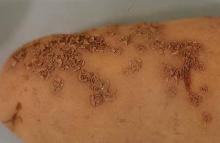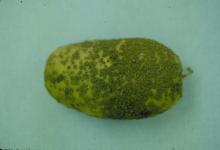By A. Moore, K. Frost, and C. M. Ocamb
Cause Spongospora subterranea, a biotrophic soilborne organism belonging to Phytomyxea, is carried on seed tubers and can survive 3 to 10 years as cysts (sporosori spore balls) in soil. This microorganism is the primary vector of potato mop-top virus. Sporosori germination results in the release of swimming zoospores, and the zoospores are responsible for continued infection throughout the growing season. Disease is promoted by wet soils and soil temperatures below 68°F.
Symptoms Scabs can be observed as purple to brown raised lesions on the tuber surface. It usually is evident that the potato's epidermis has broken away to expose the powdery masses of sporosori. Lesions are typically very small in diameter during early infection (< 0.1 inch) and can expand to 0.3 inches in diameter. Symptoms can present similarly to those caused by common scab; however, they can be differentiated by scraping lesions and observing sporosori microscopically.
Small white galls form on the roots of some potatoes and other plants in the Solanaceae family, and these galls darken with age. Galls also serve as structures for sporosori multiplication and result from the expansion of infected root cells. Zoospores can be released from sporosori located in both scabs and galls. They also germinate as a result of root hair infection, however these sites of infection are unobservable without light microscopy and do not manifest in visible symptoms.
Infected tubers are susceptible to secondary pathogens while in storage and may be associated with increased problems with Fusarium dry rot.
Cultural control
- Avoid planting symptomatic, infected, or infested seed tubers.
- Avoid planting on ground known to be infested with S. subterranea. PCR-based assays are available to detect presence of S. subterranea in soils.
- Avoid using peat-based potting mixes that may contain this pathogen.
- Rotate out of potatoes for 3 or more years if possible.
- Do not move contaminated soil to clean fields on field machinery, shovels, or boots.
- Reduce irrigation; excessive irrigation favors the disease.
- There is less damage to 'Russet' varieties than to smooth-skin varieties.
Chemical control
- Omega 500F (Group 29) at 24 to 48 fl oz/A banded in-furrow for disease suppression; use the higher rate for fields with a high inoculum load. This product's efficiency varies based on the intensity of disease pressure. Omega 500F will not reduce pathogen numbers in the soil but will be most effective against symptom development if sporosori levels are low in soil. Do not apply within 14 days of harvest. 12-hr reentry.
Reference Mallik, I., Fulladolsa, A.C., Yellareddygari, S.K.R., Bittara, F.G., Charkowski, A.O., and Gudmestad, N.C. 2019. Detection and quantification of Spongospora subterranea sporosori in soil by quantitative real-time PCR. Plant Dis. 103(12):3189-3198. doi:10.1094/PDIS-05-19-1092-RE.




